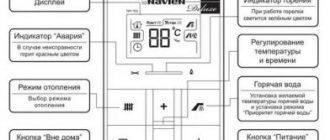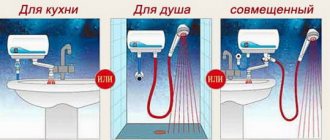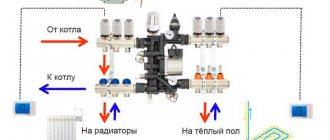The most common today in most countries, including Russia, are heating systems filled with liquid coolant. This is a set of equipment - complex or simple. In the latter case we are talking about an open circuit. As part of such systems:
- boiler rooms;
- heat exchangers;
- pumping equipment stations.
All nodes are connected to each other by a pipeline. The quality and characteristics of the circulating fluid will affect the operation of the equipment, which is why it is so important to choose the right coolant, which will be discussed in the article.
What should the coolant be?
If you are faced with the question of how to fill the heating system in a private house, then you must figure out what the coolant should be. An ideal liquid for this role has not yet been invented. This indicates that each of the known materials is operated under certain conditions.
An important factor is the temperature of the coolant, if violated, the substance can change its properties, which leads to the system stopping. The correct coolant should transfer a greater amount of heat in a short time, it should have low viscosity, it should not cause corrosion and should not pose a danger to the inhabitants of the house. Among other things, when transferring heat, heat loss should be minimal, and low viscosity will be an indicator of pumping speed and increased efficiency.
If you are thinking about the question of how to fill the heating system in a private home, you should know that one or another coolant can cause corrosion, as a result of which you will encounter restrictions when choosing mechanisms and parts of the system.
Safety of use
If we are talking about safety, then the coolant should not exceed the standards for toxicity and ignition temperature; the same requirements also apply to liquid vapor. An important factor when choosing is cost. The price must be relatively low, otherwise the consumer must be able to use the coolant for a long time without replacing it.
Water use
Before deciding what to fill the heating system in a private home with, you should consider the most common options for solving this issue. One of them is water, the advantages of which are expressed in the highest heat capacity among all liquids, as well as a lower density. Thus, a kilogram of water whose temperature is 90 °C will cool to 70 °C, releasing heat in the amount of 20 kcal.
When deciding what to pour into the heating system of a private house with an electric boiler, you can consider water as an option, which differs in environmental and toxicological properties from synthetic substances. It is safe for humans, and if a leak occurs, it will not cause additional trouble. Such a coolant can be easily obtained; if there is insufficient volume, pour the required amount into the system. This coolant has no competitors in price; a cheaper liquid simply cannot be found.
How to fill a heating system with water
Anyone can face the problem of filling a heating system with water, and not everyone can afford to invite specialists to do such work, and in modern times one doesn’t always want to trust advertising and sales.
Most often, installation of heating pipelines is carried out using metal-plastic pipes due to their practicality and reasonable price.
Filling the heating system with water
Diagram of a water heating device.
The reasons for filling the heating system can be: possible emergency situations due to which it was necessary to drain the water, seasonal discharge of water, release of air pockets.
Before filling the heating system with water, especially if it is being started for the first time, it is necessary to flush it. Inside the structural elements of the system, remnants of factory-made shavings and preservative reagents may be found.
If the system is not being filled for the first time, then during its service life, substances dangerous to proper operation, such as scale and limestone, have accumulated in the heating registers and pipes. All these products can cause serious damage to the boiler and the entire system.
Return to contents
Flushing the system before starting
Water heating scheme.
If there is water in the heating system, it must be drained. Next, you should dismantle the heating radiators. Then connect the pipes for supplying water from the water supply system to the outlet of the system, and the drain pipe to the entrance to the system. All formed connections must be well secured with pre-prepared clamps. It should be remembered that the higher the pressure the water is supplied with, the better the cleaning will be (but not more than two atmospheres). A pump is usually used to create pressure. You can sprinkle bleach on the water to achieve a disinfectant effect. On average, this procedure can take about two hours. Upon completion, clean water without additional impurities will come out of the drain.
The heating system can be cleaned using special chemicals: additives or anti-corrosion liquids. They should be treated with caution, since they are not suitable for all materials and can damage some elements of the system.
After cleaning, the radiators are installed in the opposite direction of their dismantling. You should additionally check the tightness of the system by visual inspection and identifying leaks.
Return to contents
How to determine the amount of fluid for the system
Scheme of a two-pipe water heating system with natural circulation:
1 – heater 2 – main riser 3 – expansion tank 4 – hot water line 5 – hot water risers to radiators 6 – heating radiators 7 – chilled water drain pipes 8 – chilled water line (return) 9 – furnace.
To avoid excessive overflow of water into the heating system or lack of water, which can lead to the destruction of structural elements of the system, boiling of water, and the formation of scale in pipes and radiators, you need to accurately calculate the required volume of water. For this, there is a simple formula that sums up the capacity of all radiators, the heating boiler, the volume of the expansion tank and other additional elements for passing water, including pipes. The formula for calculating the volume of water in pipes is as follows: π (3.14) × r pipes × total length of pipes. About 20% is added to the total value as a margin.
You can also determine the required volume of water to fill the system during flushing by installing a water consumption meter at the entrance to the system. The readings as the system fills must be remembered and used when filling.
Once everything is ready to fill the system, you should prepare or double-check the list of necessary materials and tools.
To do this you will need the following materials:
- gaskets (in case you need to seal pipe connections after checking the tightness of the system)
- sealing tapes for pipes (used to eliminate small leaks from the outside)
- hoses (necessary for supplying water to the vibrating household pump and draining water to the heating system)
- plastic container (tank for collecting coolant before pumping it into the heating system)
- clamps (needed to seal the connections between the hoses and the vibration pump).
- pliers (necessary for fixing clamps on hoses to attach them to the pump)
- household vibration pump (used to force water from a container into the heating system)
- pressure gauge (with its help you can easily measure the current pressure in the system).
Return to contents
Classification of heating systems
To properly fill a water heating system. you need to know what type it is. There is a classification of systems according to the method of pipe routing: from the top, from the bottom, horizontal, vertical or combined. According to the method of connecting devices using pipes, systems are divided into: single-pipe and double-pipe.
For reference
If you are faced with the task of how to fill the heating system in a private house, you must take into account that water in its usual form should not be used, because it is rich in salts and oxygen. Over time, such additives will cause scale to settle on the internal surfaces of the heating system and corrosion will appear. And in order for the system to work without interruption, the liquid must be softened before use.
To do this, you can use one of the existing methods. This may be thermal or chemical technology. In the first case, the technique is based on boiling. The water must be placed in a metal tank in which it must be heated. When boiling, carbon dioxide will be removed, and salts will be deposited at the bottom of the vessel. Stable magnesium and calcium compounds will still remain in the water. The chemical method works using reagents. With the help of soda ash, sodium orthophosphate and slaked lime, the salts become insoluble and precipitate. Subsequent filtration will eliminate any remaining harmful substances.
Video on filling the heating system
The heating system is filled, the air has been removed, and the work can be considered complete. After some time, you may need to remove air from one or more radiators, because there is still some air in the system. Partially it will be removed through an automatic air vent.
Operations prior to filling the system
Whether we are launching a new heating system, or putting back into operation after the summer one that has been in service for more than one year, but from which the liquid has been drained, before starting it is always necessary to carry out the following mandatory operations:
- Flushing the heating system is mandatory for a new system in order to remove process debris and scale from pipes that may interfere with heat transfer. If the coolant was not drained in the summer (with proper operation), then flushing the system volume with water can be carried out every two years
- The hydraulic test is carried out with compressed air, but it can also be done by increasing the pressure of the coolant (water, antifreeze). Calculation of pressure for crimping is carried out by multiplying the working pressure by 1.25. The rate of pressure drop should be no more than 1% in 15 minutes
Manual pump for pressure testing of heating manufactured by Rothenberger
- Elimination of all leaks detected during testing (tightening and re-tightening of oil seals and seals). This is necessary not so much to ensure that the consumption of replenishing the volume of the heating system of the house with coolant is minimal, but to prevent airing during operation.
What is better to fill with antifreeze or water?
The most common method is to fill the heating volume with water, but recently, especially for small house systems, antifreeze is increasingly being used, which has many advantages (except for the relatively high price, of course).
It should be taken into account that water as a coolant also requires costs; it must be prepared (remove salts and oxygen) before filling the heating volume with it, and cold water treatment systems and reagents for them cost some money.
If you use water as a coolant, then keep in mind that liquid from the water supply is least suitable for this purpose. It contains calcium salts and other substances that cause deposits on pipeline elements. In addition, tap water is characterized by a large volume of dissolved oxygen. To prepare it, it is advisable to use special chemical water treatment plants.
So the decision to use a special liquid as a coolant is justified in many cases.
How to calculate the volume of coolant
To select equipment for water treatment (to select the rate at which replenishment flow occurs, and therefore calculate the speed of its operation), or when using antifreeze or imported water as a coolant, you need to know the volume size of your heating system. How to calculate it?
- We find or make a specification for the heating system of your home (you need to know all the elements, their quantity and the diameter of the pipes)
- The volume of water in the boiler itself (G), in the radiator section (P) and in the expansion tank (O) is found in passports or catalogs
- In order to calculate the volume that liquid occupies in pipes, we use special reference books that indicate the volume of water in one linear meter (D) depending on the diameter
- We find the volume using the formula O+G+(P*c)+(D*z) . where c is the number of radiator sections, z is the number of linear meters of pipe
- Although water or antifreeze is an incompressible liquid, the calculation still has some error, so we add 10-15% of the reserve.
Preparing and filling the system
Even a system that has an accurate calculation of hydraulic parameters will not be able to work well if there was an error at the start of operation, and the coolant flow in individual components is very difficult to adjust.
When everything has been washed and tested, calculations have been made and the required volume of softened water or antifreeze has been prepared, you can begin preparing to fill the heating system. At this stage, as well as at such a stage as starting the heating system, it is advisable to forget what speed is; all operations must be performed correctly:
- We inspect all system components for possible leaks
- We close all drain pipes and taps; we don’t need liquid flow through them
- We check the operation of all air venting devices; if the rate of air discharge through them is insufficient, turn them off altogether. Also, if possible, open all the taps at the highest points; the air flow through them will reduce the time for the operation.
Why do many people refuse water?
If you are faced with the question of what to put into the heating system of a private house for the winter, then most likely you will have to give up water. In this case, a coolant parameter such as temperature plays an important role. If the temperature in the building drops below 0 °C, the liquid will freeze and this will cause a breakdown of the heating system.
Types of individual heating systems
In private residential buildings, two types of heating systems are installed; how to fill the coolant depends on their design.
Open gravity
In houses with a height of no more than two floors, when installing only heat exchange radiators to heat the premises, they usually install a gravity heating system with a large capacity tank at the top. Circular circulation of the coolant along the circuit occurs by gravity due to the pushing out of less dense hot water heated in the boiler by cold water masses. The pipeline is laid with a slight slope towards the boiler in such a way that the liquid from the return line flows into the heater by gravity.
The heating main has only one point open to external access in the form of an expansion tank, through which antifreeze is usually poured into the heating system of the house. After evaporation or leaks, you can also add water through the tank. The option of bottom filling of the coolant into the gravity system through a drain pipe with a shut-off ball valve mounted at the lowest point of the pipeline cannot be ruled out. However, with this method, you will have to supply the liquid with pressure, for which you will need special water pressure equipment - an electric pump or its manual equivalent, a pressure testing device.
Rice. 2 Designs of gravity and closed systems
Closed
In high-rise buildings with extended heating circuits for underfloor heating, a gravity-flow system cannot cope with large volumes of coolant pumping and high hydraulic resistance of the line. In these cases, to ensure the movement of liquid through a long pipeline, an electric circulation pump is added to the main line (for heated floors, another additional unit is installed), the circuit is closed and a sealed hydraulic accumulator is installed instead of an open storage tank.
Water is poured into a closed-type heating system through the drain pipe at the bottom of the pipeline; to create the required water pressure in the line, the coolant is supplied by an electric pump or pressure tester.
Rice. 3 Comparison table of water and glycol parameters
Related article:
Scheme of a closed heating system with forced circulation . A separate article describes in detail about a closed heating system, its elements, and provides a diagram for independent design and installation!
Application of antifreeze
When cold weather sets in, the so-called anti-freeze agent, which is a special liquid for heating systems, becomes relevant. If the pipes are filled with such a coolant, then even if the temperature drops to critical, they will not burst, which is very important for housing that is used irregularly. In this case, antifreeze is used as an energy carrier, which is designed to operate over a wide temperature range, varying from -30 to -65 °C.
When the question arises about what to pour into the heating system of a private house in winter, then it is worth paying attention to this option, which does not harden, but takes on an altered gel-like state when the temperature drops below 0 °C.
Returning to its original state, antifreeze will not lose its original properties and will not pose a threat to the heating system circuit. To remove pockets of corrosion or scale, manufacturers use additives in the form of special inhibitors. Thanks to this, the service life of the heating system can be increased by several years.
How recharge works
The main task of the make-up unit is to add the missing coolant to the heating system until the operating pressure returns to normal. In most cases, heating make-up is connected to a cold water supply, but the system can also be powered from a storage tank. There are two ways to replenish the coolant volume.
- Manual mode. It is usually used in small systems. The user himself periodically monitors the pressure using the pressure gauge and, when necessary, opens the appropriate taps. Water flows by gravity, or a make-up pump is used for heating. In the simplest gravity installations, water is collected until it comes out of an overflow pipe welded to the expansion tank.
- Automatic recharge of the heating system. If the pressure in the system drops below the set value, the heating system feed valve (or electric valve/valve) is activated, which opens the flow hole. If necessary, voltage is applied in parallel to the sediment, and water will begin to forcefully enter the system. When the pressure readings return to normal, the valve will close and the pumping equipment will turn off. Sometimes the power supply is part of the heat generator. The advantage of using automation is that there is no need to engage in control; everything happens without the participation of the homeowner. The disadvantage is the fact that another element appears in the circuit that needs power supply.
Note that this unit is used not only for adding water during operation. Through it the following is carried out:
- initial filling of coolant into the system;
- complete discharge of water (for example, for repairs);
- water preparation (coarse filtration, softening);
- flushing the system;
- crimping.
What to consider before choosing antifreeze
If you still cannot decide what to pour into the heating system of a private home - water or antifreeze - then you should take into account the fact that the last of the listed options is designed for only a few seasons of operation. It could be 5 years, or rather 10 seasons. After this period, the coolant volume must be replaced. Manufacturers even recommend using antifreeze for about 3 years.
Features of using non-freezing liquids
If there is a risk of heating system freezing, you need to think about protection in advance
When designing a heating system, you have to choose whether water or antifreeze will circulate in the pipes.
These liquids differ primarily in their freezing point: if water at 0 ° C turns into ice and can break the pipe, then antifreeze remains fluid at -60...-70 ° C. For houses in which the heating system is used irregularly, this is a real salvation: the risk of pipes failing at low temperatures is minimized.
On the other hand, if we want to use antifreeze, then we need to take into account its features:
To compensate for the loss of heat capacity, you need to use a higher power boiler
- Lower heat capacity - 15–20% lower than that of water. The coolant warms up more slowly and transfers heat less well, which means that efficiency losses must be compensated by installing a more powerful heating boiler.
- Greater fluidity due to lower surface tension. This does not seem to be a serious problem only at first glance: as soon as the pipes cool down, the coolant begins to leak through all the joints and connections. This must be taken into account when designing circuits and connecting equipment.
High viscosity of the compositions requires the use of circulation pumps
- High density and viscosity. The movement of antifreeze through the pipes will be difficult, which means we will need a more powerful circulation pump. In addition, if you initially plan to use non-freezing liquid as a coolant, then it is better to immediately choose pipes of a larger diameter.
- Expansion when heated. Antifreeze for heating systems expands in volume 30–50% more than water. Accordingly, the expansion tank also needs to be installed larger.
Metal corrosion caused by antifreeze can lead to heater failure
To summarize, I would like to note that simply replacing water with antifreeze without replacing the elements of the heating system will not bring the desired result. The transition must be carefully planned, and only after making adjustments to the system design should we proceed to filling it.
Over time, the composition needs to be changed - this also leads to additional costs
Which coolant is suitable for aluminum radiators
For a system of aluminum radiators, you can use a coolant based on ethyl alcohol, which you can easily prepare yourself. Ultimately, it will be possible to obtain a liquid that will be a non-freezing mixture containing ethyl alcohol and distilled water. This liquid will have a slightly higher viscosity compared to ordinary water. However, this figure will be lower than that of factory antifreeze.
The fluidity of this liquid is less compared to antifreeze, which makes it possible to neglect the requirements for the tightness of the circuit connections. Such a liquid will not be able to damage the rubber seals of the system. When consumers think about the question of what to pour into the heating system of a private house with aluminum radiators, they try to choose just such mixtures, since they have one important advantage over other options, which is expressed in the ability to use compositions for metal radiators. This is due to the fact that alcohol will prevent the development of corrosion, and this is important for those systems whose destruction can cause unpleasant consequences. In this case, it is recommended to use hard water, which, together with alcohol, will prevent the formation of scale on the internal surfaces of the products. The sediment will form in solid form, and with preventative flushing it can be easily removed.











